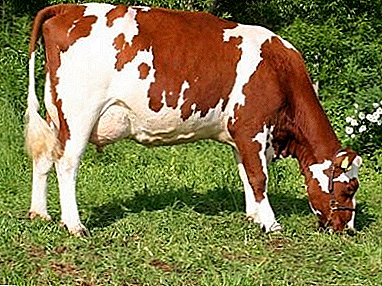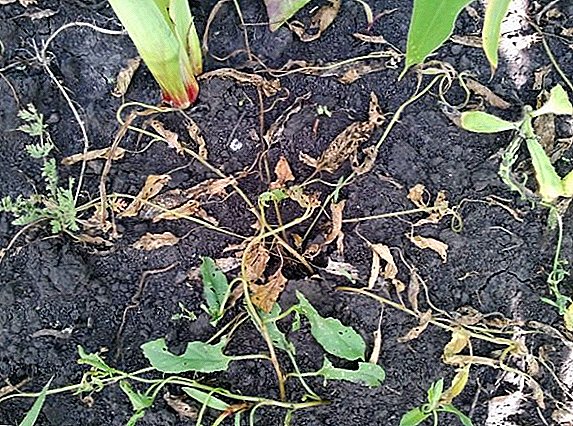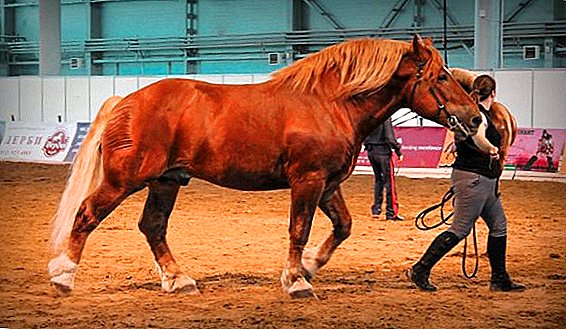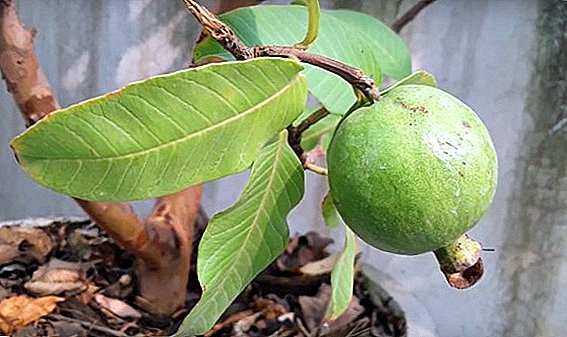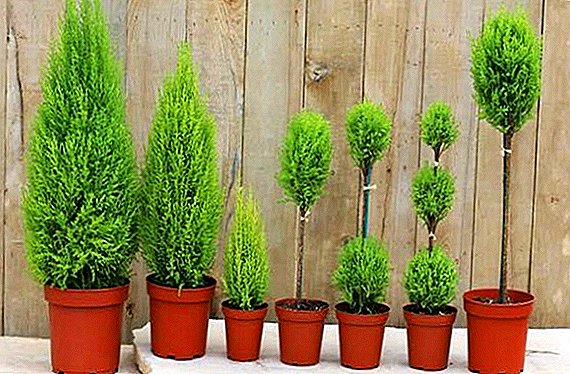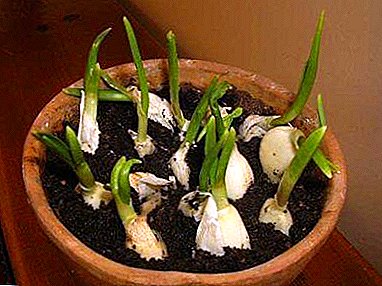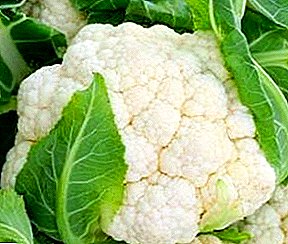
Cauliflower is almost as popular in Russia as white cabbage, but in terms of the content of some vitamins, minerals and fiber, it almost surpasses the latter.
Proper storage of cauliflower allows you to save in the autumn-winter period the precious crop.
However, even if the vegetables were grown properly, in compliance with all standards, gardeners still have to pick up all the cauliflower from the site with minimal losses.
It is necessary to choose the right time to harvest, use the appropriate tools and prepare the cabbage for prolonged storage. You will also have to take into account the weather conditions and timely monitor the degree of maturity of the whimsical product.
Are you afraid of frost?
 Is cauliflower afraid of autumn frosts? Cauliflower is known among other vegetables for extreme thermophilia.
Is cauliflower afraid of autumn frosts? Cauliflower is known among other vegetables for extreme thermophilia.
If the ambient temperature falls below + 8-10˚ C, then at the base of the white inflorescence small heads begin to form, which will later become spare shoots. The development of the main inflorescence is likely to stop.
The growth of cauliflower with the onset of cold weather is significantly slowed down, which requires the immediate sending of their ripening at home. Strong frosts can damage cabbage, but they still have the opportunity to save with the help of greenhouses.
This is easy to implement only if a stable temperature of + 10 ° C is maintained inside.
And how to freeze the cauliflower in the freezer for cooking in the winter, you can learn from our other article. Learn also about how to dry the cabbage harvest at home in an oven or an electric dryer for vegetables.
Collection dates
When is the right time to cut the cabbage? The timing of harvesting cauliflower is directly dependent on the variety and whether she managed to ripen. Early cabbage (varieties such as White Perfection, Alrani and Frünerte) usually ripens in 80-110 days, therefore, you can start harvesting them from the bed in mid-June.
Mid-season ("Bianca", "Yarik F1", "Amethyst F1") will ripen in 100-135 days, i.e. to the beginning or middle of July. In the fall, the harvest is of late cauliflower, since it grows a little more than 5 months.
We'll have to focus on the individual heads, checking the status of absolutely everyone. Those that have matured, it is better to immediately chop off at the root and remove for storage. As for the rest, they need to be monitored until full maturity. Cope with all the work more than possible for 2-3 visits.
You should not wait for a massive harvest with heavy goose-heads. Estimate cauliflower in size. Fully formed specimens can be considered as heads of 8–13 cm in diameter.. Cabbage blossoms can ripen, reaching a weight of 300 grams or 1.5 kg, which is almost the maximum allowed.
Taste parameters will also deteriorate, and nutrients will no longer be contained in the product with the same abundance. That cabbage which for some time before ripening was slightly covered from direct sunlight with its own leaves will be good.
On how to properly cover the cabbage from the sun's rays, you will learn from this video:
Average, the collection is optimal to begin in June-August, so as not to overlook the ripe heads, since ripening proceeds rather unevenly.
 It is unacceptable to wait for the cabbage to pick up more than the optimal weight, otherwise you risk getting tasteless overripe vegetables.
It is unacceptable to wait for the cabbage to pick up more than the optimal weight, otherwise you risk getting tasteless overripe vegetables.
It is easy to determine ripe cabbage or not, it is possible by its appearance. The color of ripe cabbage can be milky white or light cream. The "heads" of cabbage should be dense and relief to the touch, without suspicious looseness and softness.
You can find out how and in what time it is necessary to remove Brussels sprouts, white cabbage or kohlrabi from the garden, from our articles.
Weather
What weather to pick cauliflower? To harvest ripe cauliflower is better to proceed in dry and cloudless weather.. Morning and evening time of the day is not suitable for these purposes - condensate from humid air accumulates on the foliage and seedlings. It is better to start collecting lunch and until 19:00.
In no case do not undertake to cut cabbage during a period of heavy rainfall or immediately after precipitation. Such cabbage will not be able to be stored for a long time, it will quickly lose its characteristic aroma and lose its richness of taste.
During sprouting, cabbage likes moist, warm weather, but even with the onset of frosts, unripe vegetables can be harvested without any damage to the crop and left to ripen.
For these purposes, specially-equipped greenhouses or greenhouses, as well as terraces and even cellars are ideal. Immature cabbage is not cut, but carefully dug together with roots and clods of the earthso that they do not lose moisture and nutrients.
What temperature is recommended to clean? The best temperature conditions are considered to be 15-20 ° C above zero.. The weather should be mild, not too cold and not too hot. Critical situation will be forced cabbage harvest, if severe frosts hit, when the temperature is below + 8 ° C.
How and when it is necessary to remove the cauliflower from the garden, you can learn from the video:
How to cut?
 What garden tools to use? A standard kitchen knife is suitable, provided that the blade is heavy and carefully sharpened. Secateurs for these purposes will not work - there is a risk of making a too uneven, torn cut.
What garden tools to use? A standard kitchen knife is suitable, provided that the blade is heavy and carefully sharpened. Secateurs for these purposes will not work - there is a risk of making a too uneven, torn cut.
The best choice is a small sharpened ax., but it will be problematic for them to cut off the right amount of stem. If necessary, use woven garden gloves to avoid getting dirty in the dirt and not accidentally damaging the vegetables with your nails.
Cut off the ripe cauliflower with a small section of the stem (there should be a stalk about 2-3 cm long), capturing several green leaves (2-3 pieces). If you plan to use sprouted shoots that look like small, underdeveloped cabbage heads, then do not cut off the largest ones.
Immediately after the crop was harvested, it must be removed from the site and sheltered from the sun. Thus, you protect your reserves from premature damage and keep them presentable.
Conclusion
If the cauliflower was grown in favorable conditions, with the observance of the time necessary to feed and sufficient regular irrigation, then by the time of harvest you will have a wonderful harvest.
Read our articles about the rules of storage of all types of cabbage at home and in the basement or cellar.
Whatever variety of cauliflower grows on your plot, pay attention to the ripening period, keep track of those that are already ripe, and carefully cut them with a clean knife. Warm weather, when there was no rain for several weeks, will be a great time to gather.
Try not to overdo the vegetables in the garden for longer than the allotted time, otherwise the inflorescences will get a yellow tint, loosen and lose an impressive proportion of taste and nutrients.
There is no cause for concern if the cabbage has not yet ripened, and it begins to get cold in the yard. You can collect injured from low temperatures heads with a diameter of 5 cm and send them to ripen in a greenhouse.


